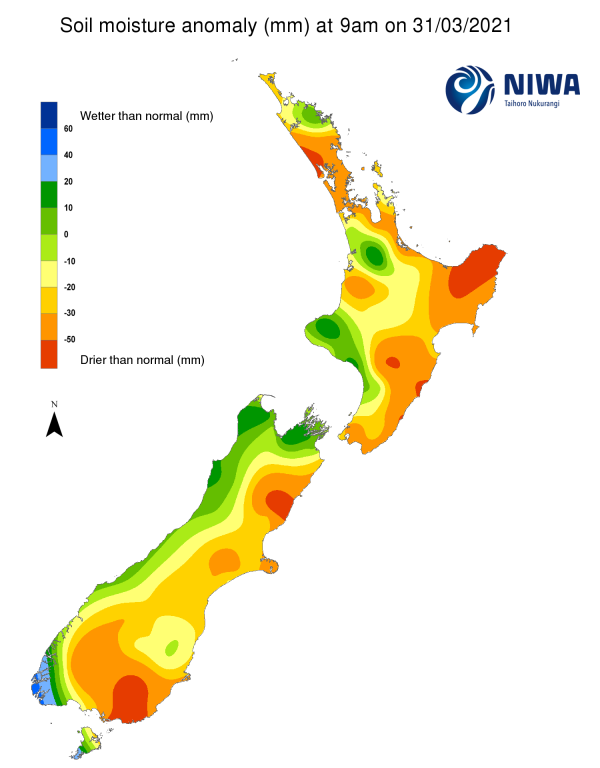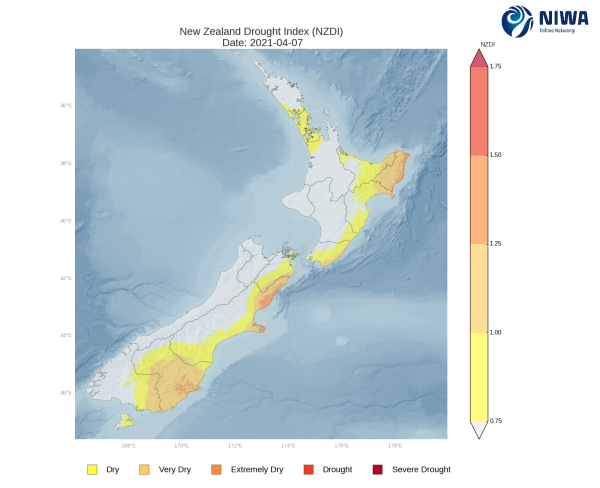A weekly update describing soil moisture patterns across the country to show where dry to extremely dry conditions are occurring or imminent. Regions experiencing significant soil moisture deficits are deemed “hotspots”. Persistent hotspot regions have the potential to develop into drought.
Please note that this will be the final Hotspot Watch update for this season. Weekly Hotspot Watches will return in the spring.
Facts: Soil Moisture
In the North Island, minimal rainfall was observed nearly everywhere in the past week, with amounts generally 5 mm or less. Coastal parts of Gisborne and Hawke’s Bay received up to 15 mm, however. This resulted in soil moisture decreases for most areas, although the western North Island did see soil moisture increases due to rainfall that occurred slightly more than a week ago. The driest soils across the North Island, when compared to normal for this time of the year, are found in western Northland, eastern Bay of Plenty and Gisborne, while the wettest soils for this time of the year for the North Island are found in Taranaki and northern Manawatū-Whanganui.
Hotspot conditions are currently found near Cape Reinga, southern Northland, parts of Auckland, eastern Bay of Plenty, most of Gisborne, and Napier south to Tararua District. The New Zealand Drought Index (NZDI) map below shows that widespread dry to very dry conditions are in place across most of the eastern North Island. Small areas of extremely dry conditions are also located in coastal Gisborne.
In the South Island, moderate rainfall of 20-50 mm was observed across much of the West Coast in the past week, with pockets of up to 75 mm. However, the rest of the South Island only received meagre rainfall, with most locations seeing less than 5 mm. This resulted in small to moderate soil moisture decreases across almost all of the South Island, although rainfall slightly more than a week ago led to soil moisture increases in northern Marlborough. The driest soils in the South Island compared to normal for this time of year are located in coastal Hurunui District and much of Southland, while the wettest soils for this time of the year for the South Island are found in northern Marlborough and Fiordland.
Hotspots conditions are currently in place across most of Canterbury, Otago, and eastern Southland. The New Zealand Drought Index (NZDI) map below shows that widespread dry to very dry conditions are in place across most of the northeastern South Island, as well as Otago and eastern Southland. Small areas of extremely dry conditions are also located in northern Canterbury, and eastern Otago.
Outlook and Soil Moisture
A front will move across the North Island late Saturday through Sunday morning (10-11 April), bringing moderate to heavy rainfall to many areas. Another front arriving on Tuesday could deliver more moderate rain. From mid to late next week, a westerly wind flow will bring scattered showers and rain especially to western portions of the North Island. Weekly rainfall totals could be substantial in the western and central North Island, where amounts could exceed 60 mm. The upper North Island may see up to 40 mm, while lesser amounts near 20 mm are likely along the east coast.
The expected moderate to heavy rainfall should result in small to moderate soil moisture increases across much of the North Island. However, soil moisture levels may not change significantly in the eastern North Island. The current hotspots in the upper North Island are likely to weaken during the next week, while those along the east coast may not change significantly.
In the South Island, low pressure will bring heavy rain to the West Coast and upper South Island on Saturday (10 April), but minimal rainfall along the east coast. Another area of low pressure will bring a similar scenario early next week, with more heavy rain in western areas. A third area of low pressure will once again deliver moderate to heavy rain on Thursday (15 April). Weekly rainfall totals may exceed 200 mm along much of the West Coast, with near 100 mm around Nelson, and up to 50 mm in the lower South Island. However, the eastern South Island will once again see much lighter rainfall, where weekly totals may be less than 20 mm.
Due to the expected weekly rainfall, locations in the western and upper South Island will likely see moderate to large soil moisture increases during the next week. However, minor decreases may be observed in the eastern South Island. While hotspots in the lower South Island may weaken slightly during the next week, those in Canterbury may strengthen slightly.
Background:
Hotspot Watch: a weekly advisory service for New Zealand media. It provides soil moisture and precipitation measurements around the country to help assess whether extremely dry conditions are imminent.
Soil moisture deficit: the amount of water needed to bring the soil moisture content back to field capacity, which is the maximum amount of water the soil can hold.
Soil moisture anomaly: the difference between the historical normal soil moisture deficit (or surplus) for a given time of year and actual soil moisture deficits.
Definitions: “Extremely” and “severely” dry soils are based on a combination of the current soil moisture status and the difference from normal soil moisture (see soil moisture maps)
Hotspot: A hotspot is declared if soils are "severely drier than normal" which occurs when Soil Moisture Deficit (SMD) is less than -110 mm AND the Soil Moisture Anomaly is less than -20 mm.
Pictured above: Soil Moisture Anomaly Maps, relative to this time of year. The maps show soil moisture anomaly for the past two weeks.
New Zealand Drought Index (NZDI)
As of 7 April, the New Zealand Drought Index (NZDI) map below shows that widespread dry to very dry conditions are in place across most of the eastern North Island, northeastern South Island, as well as Otago and eastern Southland. Small areas of extremely dry conditions are also located in coastal Gisborne, northern Canterbury, and eastern Otago. However, meteorological drought is not currently found in New Zealand. Please note: some hotspots in the text above may not correspond with the NZDI map. This difference exists because the NZDI uses additional dryness indices, including one which integrates the rainfall deficit over the past 60 days. Changes are therefore slower to appear in the NZDI compared to soil moisture anomaly maps that are instantaneously updated.




